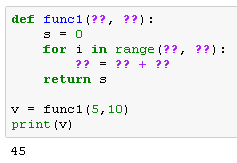2-6 函數
函數(函式,function)是邏輯結構化和過程化的一種編程方法
如何自定函數 ?
def函def 函數名稱 (參數1, 參數2, ....) :
函數的詳細內容
:
return 傳回值
如何呼叫自定函數 ?
函數名稱(參數1, 參數2, ....)
傳回值 = 函數名稱(參數1, 參數2, ....)
範例1:輸入3小時25分,顯示等於多少秒數
def myfunc (h, m):
value = (h * 60 + m) * 60
return value
sec = myfunc(3, 25)
print (sec)
輸出結果為 12300
範例2:輸入圓的半徑,計算圓面積
def area(radius):
result = radius * radius * 3.14
return result
print(area(10))
輸出結果為 314.0
練習1:輸入兩個整數(例如首項=5、末項=10),計算兩數字之間(包含兩數字)所有整數總和 (參考答案 = 45 )

練習2: 輸入兩個整數(例如首項=5、末項=10),計算兩數字之間(包含兩數字)所有整數平方和 (參考答案=355)
練習3: 輸入兩個整數(首項=5、末項=10),計算兩數字之間(包含兩數字)所有奇數總和 (參考答案=21)
函數的三大好處
- 代碼重複使用
- 保持一致性
- 可擴展性
可參考: https://ithelp.ithome.com.tw/articles/10187997
Python的內建函數
len() :回傳資料的長度或資料包含的元素數量
>>> len("This is a book.")
15
>>> a = ['a', 'b', 123]
>>> len(a)
3
max()、min():回傳最大值、最小值
>>> max (100, 500, 50)
500
>>> min (100, 500, 50)
50
>>>
sorted():排序
排序規則:數字 < 大寫英文字母 < 小寫英文字母 < 中文
=a=[3, 4, 1, 2, 5]
print(sorted(a))如果是字串中的資料,也可以用「split」切開變成list,再去排序:
a="3 4 1 2 5 0"
b=a.split()
print(sorted(b))
type():顯示變數的資料型態
x = 123
y = 12.3
z = '123'
a = ['張三', '李四' , 123]
b = ('張三', '李四', 123)
c = {1:'一月', 2:'二月', 3:'三月'}
d = {'張三', '李四', 123, 123}
print (type(x))
print (type(y))
print (type(z))
print (type(a))
print (type(b))
print (type(c))
print (type(d))
輸出結果:
<class 'int'>
<class 'float'>
<class 'str'>
<class 'list'>
<class 'tuple'>
<class 'dict'>
<class 'set'>
